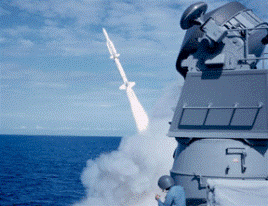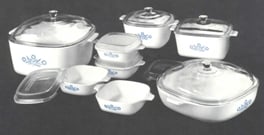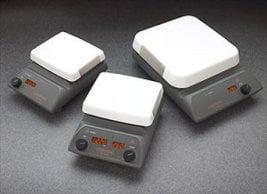Figure 1
Terrier missile being test fired from the deck of the USS Harry E. Yarnell DLG-17. These radar-guided anti-aircraft missiles were equipped with Corning Pyroceram® radomes (nosecones) during the late 1950s. Photo courtesy of Carlos Royal.
In 1952, one of Corning's scientists, Dr. S. D. Stookey, made an accidental but important discovery when an oven malfunction overheated a piece of photosensitive glass on which he was working. The glass turned milky white as a result of heat-induced crystallization and did not break when dropped. The result was a ceramic-like material, the first in a new family of glass-ceramic materials that has led Corning into several new businesses.

Figure 1
Terrier missile being test fired from the deck of the USS Harry E. Yarnell DLG-17. These radar-guided anti-aircraft missiles were equipped with Corning Pyroceram® radomes (nosecones) during the late 1950s. Photo courtesy of Carlos Royal.
This new Pyroceram® glass-ceramic material was extremely durable, corrosion resistant and had a very low coefficient of expansion. It was also transparent to radar, which made it ideal for use as nosecones on anti-aircraft missiles (Figure 1).
These space age characteristics allowed Pyroceram glass-ceramics to be very successfully adapted for commercial use as Corningware® products for cooking in 1959 (Figure 2). Pyroceram glass-ceramic's transparency to radar (microwaves) also allowed Corningware products to be used in microwave ovens, greatly extending their versatility in the kitchen.

Figure 2
Corningware Pyroceram® heat resistant cookware was an instant hit with people who liked their looks as well as their performance.
Pyroceram glass-ceramics next found a place in biology and chemistry laboratories when they were used in 1964 to make tops for Corning® hot plates and stirrers (Figure 3). Unlike metal tops, glass-ceramics are easy to clean, highly resistant to scratches, corrosion and chemical attack. Pyroceram tops heat up hotter than metal typically providing temperatures 200°C above metal top products. Pyroceram tops are also white allowing easy viewing of color contrasts in such applications as titrations. As a result, it has been the material of choice for Corning hot plates for over forty years.
In 1986, Dr. Stookey was awarded the National Medal of Technology for this and other material innovations, including photosensitive and photochromic glasses, he made while working for Corning.

Figure 3
Corning’s new digital hot plates and stirrers still offer the same unique Pyroceram® tops that have set the standard for quality for over 40 years.
Sources:
Information courtesy of CORNING Life Science